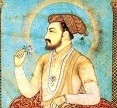Mughal Emperor Shah Jahan
Birth of Mughal Emperor Shah Jahan - [January 5, 1592] This Day in History
On 5 January 1592, Shahab-ud-din Muhammad Khurram, later known as Shah Jahan was born to Mughal Emperor Jahangir and his wife Jagat Gosaini.

Early Life of Shah Jahan
- Shah Jahan was born in Lahore, Pakistan to Prince Salim (who later became Emperor Jahangir) and his Rajput wife from Marwar Princess Jagat Gosaini. Her official Mughal name was Bilqis Makani. Shah Jahan’s grandfather was Mughal Emperor Akbar.
- Although initially named Prince Khurram, he assumed the regnal name Shah Jahan later. He was Jahangir’s third son and considered the ablest and competent to be king. After Jahangir’s death, he overthrew his rivals to the throne and emerged victoriously. He was crowned on 14 February 1628 in Agra.
- He was educated in martial arts and a variety of fine arts. He was brought up chiefly by Akbar’s first wife, the childless Empress Ruqaiya Sultan Begum.
Reign as the Emperor of the Mughal Empire
- Shah Jahan was an able military commander. While still a prince, he was able to obtain the submission of the Rajput state of Mewar which Akbar had not been able to defeat. Mewar then became a vassal of the Mughal Empire.
- On becoming the emperor, Shah Jahan executed many of his former rivals including his own brother Shahryar, imprisoned many more and consolidated his power. The Mughal rules of succession do not follow primogeniture, i.e., the eldest son succeeding the father; there is always a fight for power by brothers in the Mughal courts.
- Before becoming king, as a prince, he had been the governor of the Deccan, Bihar, Bengal, Gujarat and Delhi.
- As king, Shah Jahan expanded the military and promoted the production of arms. He annexed several territories.
- Shah Jahan married multiple times as was the custom. His favourite was said to be Arjumand Banu Begum who is better known as Mumtaz Mahal. She died during childbirth in 1631 and Shah Jahan was said to be depressed. He got the Taj Mahal built in her honour and perhaps, he is most famous for this architectural feat.
- He also created many other architectural marvels including the Pearl Mosque at Agra, the Red Fort, the Jama Masjid at Delhi, the Shalimar Gardens and some other buildings in present Pakistan. He also got the famous Peacock Throne built.
Later Life
When Shah Jahan became ill in 1658, Dara Shikoh (Mumtaz Mahal’s eldest son) assumed the role of regent in his father’s stead, which swiftly incurred the animosity of his brothers. Upon learning of his assumption of the regency, his younger brothers, Shuja, Viceroy of Bengal, and Murad Baksh, Viceroy of Gujarat, declared their independence and marched upon Agra in order to claim their riches. Aurangzeb, the third son, gathered a well-trained army and became its chief commander. He faced Dara’s army near Agra and defeated him during the Battle of Samugarh. Although Shah Jahan fully recovered from his illness, Aurangzeb declared him incompetent to rule and put him under house arrest in Agra Fort.
Jahanara Begum Sahib, Mumtaz Mahal’s first daughter, voluntarily shared his 8-year confinement and nursed him in his dotage. In January 1666, Shah Jahan fell ill. Confined to bed, he became progressively weaker until, on 22 January, he commended the ladies of the imperial court, particularly his consort of later years Akbarabadi Mahal, to the care of Jahanara. He was confined to the fort for 8 years and he was accompanied and nursed by his daughter Jahanara Begum. He died on 22 January 1666 aged 74 years.
Also on this day1952: Death of Lord Linlithgow, Viceroy of India from 1936 to 1944 (longest reign any Viceroy has had).
Comments
Post a Comment